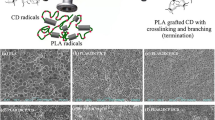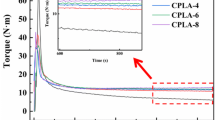Abstract
A polyfunctional isocyanate was prepared and was blocked by methanol to limit its premature reactivity with water or other nucleophiles. The methanol-blocked polyfunctional isocyanate was used as a cross-linking agent to improve the melt strength and foamability of poly(lactic acid) (PLA). The effect of the blocked polyfunctional isocyanate (BPI) content on the melting behavior, crystallization, degree of cross-linking, and melt strength of PLA was investigated, and the cellular morphologies of the PLA foams obtained by chemical foaming extrusion were studied, as well. The cold crystallization temperature increased with increasing BPI proportion and the melting peak changed from a single to multiple peaks upon the addition of BPI to PLA. The ∆Hc, ∆Hm, and Xc values initially increased and then decreased with increasing BPI content. It can be attributed to the effect of cross-linking on crystallization behavior of PLA. The degree of cross-linking increased with the BPI content of the PLA mixtures. The melt strength of the PLA mixture increased with increasing proportions of BPI, whose incorporation led to a decrease in the void fraction, cell size, and open cell content of the PLA foams but an increase in the cell density. When BPI was added to the PLA, the cell morphologies of the PLA mixtures were obviously enhanced.








Similar content being viewed by others
References
Zhou M, Zhou P, Xiong P, Qian X, Zheng H (2015) Crystallization, rheology and foam morphology of branched PLA prepared by novel type of chain extender. Macromol Res 23:231–236
Zhang R, Cai C, Liu Q, Hu S (2017) Enhancing the melt strength of poly(lactic acid) via micro-crosslinking and blending with poly(butylene adipate-co-butylene terephthalate) for the preparation of foams. J Polym Environ 25:1335–1341
Nofar M, Tabatabaei A, Sojoudiasli H, Park CB, Carreau PJ, Heuzey MC, Kamal MR (2017) Mechanical and bead foaming behavior of PLA–PBAT and PLA–PBSA blends with different morphologies. Eur Polym J 90:231–244
Zhou H, Zhao M, Qu Z, Mi J, Wang X, Deng Y (2018) Thermal and rheological properties of poly(lactic acid)/low-density polyethylene blends and their supercritical CO2 foaming behavior. J Polym Environ 26:3564–3573
Najafi N, Heuzey MC, Carreau P, Therriault D (2015) Quiescent and shear-induced crystallization of linear and branched polylactides. Rheol Acta 54:831–845
Nerkar M, Ramsay JA, Ramsay BA, Vasileiou AA, Kontopoulou M (2015) Improvements in the melt and solid-state properties of poly(lactic acid), poly-3-hydroxyoctanoate and their blends through reactive modification. Polymer 64:51–61
Julien JM, Quantin JC, Bénézet JC, Bergeret A, Lacrampe MF, Krawczak P (2015) Chemical foaming extrusion of poly(lactic acid) with chain-extenders: physical and morphological characterizations. Eur Polym J 67:40–49
Arruda LC, Magaton M, Bretas RES, Ueki MM (2015) Influence of chain extender on mechanical, thermal and morphological properties of blown films of PLA/PBAT blends. Polym Test 43:27–37
Barletta M, Moretti P, Pizzi E, Puopolo M, Tagliaferri V, Vesco S (2017) Engineering of poly lactic acids (PLAs) for melt processing: material structure and thermal properties. J Appl Polym Sci 134:44504
Ludwiczak J, Kozlowski M (2015) Foaming of polylactide in the presence of chain extender. J Polym Environ 23:137–142
Yu T, Hu C, Chen X, Li Y (2015) Effect of diisocyanates as compatibilizer on the properties of ramie/poly (lactic acid) (PLA) composites. Compos Part Appl Sci Manuf 76:20–27
Aversa C, Barletta M, Pizzi E, Puopolo M, Vesco S (2017) Wear resistance of injection moulded PLA-talc engineered bio-composites: effect of material design, thermal history and shear stresses during melt processing. Wear 390–391:184–197
Zhao X, Xu M, Ding Z, Peng S, Fang P (2017) Reactive blending toughened PLA by in situ formation of polyurethane crosslinked elastomer. Polym Sci Ser B+ 59:437–442
Krishnan S, Mohanty S, Nayak SK (2017) Renewable resource based blends of polylactic acid (PLA) and thermoplastic starch (TPS) using novel reactive compatibilization. J Polym Mater 34:525–538
Hao Y, Yang H, Pan H, Zhang H, Ran X (2018) Heat resistant and mechanical properties of biodegradable poly(lactic acid)/poly (butylene succinate) blends crosslinked by polyaryl polymethylene isocyanate. Polym Plast Technol Eng 57:1882–1892
Xu Z, Lin X, Luo C, Xiao W (2015) Preparation of blocked polyfunctional isocyanate and its application used as crosslinking agent and foaming agent in PA6 extrusion foaming. China Plast 29:98–101
Hirschl C, Biebl-Rydlo M, DeBiasio M, Mühleisen W, Neumaier L, Scherf W, Oreski G, Eder G, Chernev B, Schwab W, Kraft M (2013) Determining the degree of crosslinking of ethylene vinyl acetate photovoltaic module encapsulants—a comparative study. Sol Energy Mater Sol Cells 116:203–218
Ema Y, Ikeya M, Okamoto M (2006) Foam processing and cellular structure of polylactide-based nanocomposites. Polymer 47:5350–5359
Acknowledgements
This study was supported by Shenzhen Science and Technology Research Foundation under Grant no.: JCYJ 20170818114324998.
Author information
Authors and Affiliations
Corresponding author
Rights and permissions
About this article
Cite this article
Xu, Z., Lin, X. & Liu, H. The application of blocked polyfunctional isocyanate as a cross-linking agent in biodegradable extruded poly(lactic acid) foam. Iran Polym J 28, 417–424 (2019). https://doi.org/10.1007/s13726-019-00710-w
Received:
Accepted:
Published:
Issue Date:
DOI: https://doi.org/10.1007/s13726-019-00710-w




